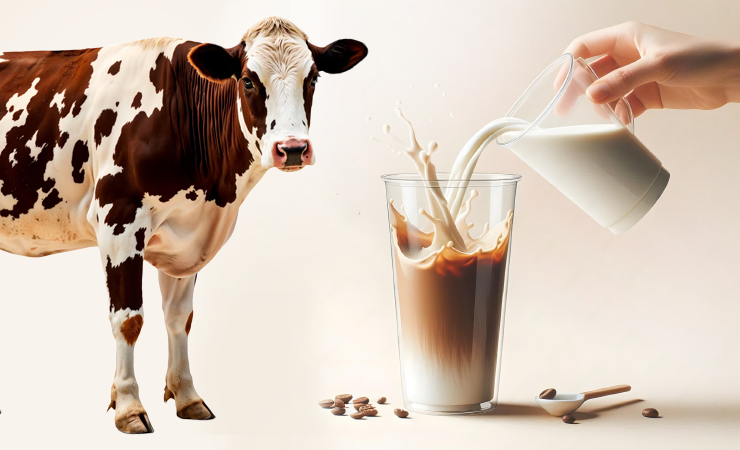For many, the day doesn’t truly begin without a latte in hand. But as more milk alternatives flood the market, the question arises: which milk is best for your health and beauty? Whether you’re looking to improve digestion, achieve glowing skin, or simply make a more nutritious choice, the type of milk you add to your latte can have a significant impact. Let’s explore the benefits and drawbacks of popular milk options to help you find the perfect match.
Dairy Milk: The Classic Choice

Traditional whole milk has long been the go-to for lattes, offering a creamy texture and rich flavor. It is packed with protein, calcium, and vitamin D—key nutrients for bone health, muscle maintenance, and even skin repair. However, dairy milk isn’t without its drawbacks:
Pros:
✔ High in protein (8g per cup) and calcium
✔ Naturally contains vitamin B12, essential for hair and nail strength
✔ Rich and creamy texture, ideal for frothing
Cons:
✘ Can contribute to acne and inflammation in sensitive individuals
✘ Contains lactose, which may cause bloating or digestive discomfort
✘ Higher in calories and saturated fat compared to plant-based alternatives
For those who tolerate dairy well, organic or grass-fed milk may be a better option, as it contains higher levels of omega-3 fatty acids and antioxidants beneficial for skin health.
Oat Milk: The Trendy Favorite

Oat milk has surged in popularity due to its naturally sweet taste and smooth, frothy texture. It is a favorite among baristas and those looking for a dairy-free alternative that still provides a creamy consistency.
Pros:
✔ Naturally sweet and creamy, making it ideal for lattes
✔ High in beta-glucans, which help lower cholesterol and support gut health
✔ Dairy-free and easy to digest
Cons:
✘ Higher in carbohydrates and sugar compared to other plant-based milks
✘ Some brands contain additives and oils that may not be skin-friendly
✘ Less protein than dairy or soy milk
For beauty-conscious latte lovers, oat milk can be a great choice, as it hydrates the skin from within and supports gut health, which is closely linked to a clear complexion.
Almond Milk: The Low-Calorie Beauty Booster

Almond milk has long been associated with beauty and wellness due to its vitamin E content, which helps protect skin from oxidative damage. It’s also one of the lowest-calorie options, making it a favorite among those watching their intake.
Pros:
✔ Low in calories and naturally dairy-free
✔ High in vitamin E, which promotes glowing skin and healthy hair
✔ Light texture, making it a good choice for those who prefer a mild latte
Cons:
✘ Low in protein, meaning it won’t keep you full for long
✘ Many brands contain added thickeners and gums that can cause digestive issues
✘ Less frothy than dairy or oat milk
If choosing almond milk, opt for an unsweetened version with minimal ingredients to maximize its health and beauty benefits.
Soy Milk: The Protein-Packed Alternative

Soy milk is the closest plant-based alternative to dairy in terms of protein content, making it a great choice for those looking to support muscle growth, healthy hair, and strong nails. It also contains isoflavones, which have been linked to improved skin elasticity.
Pros:
✔ High in protein, similar to dairy milk
✔ Contains isoflavones, which may reduce signs of aging
✔ Froths well, making it a great choice for lattes
Cons:
✘ Some people may have soy allergies or sensitivities
✘ Can be highly processed, so choosing organic is best
✘ Concerns over hormone-like effects in large amounts
Soy milk remains a solid choice for those who want the protein benefits of dairy while avoiding lactose.
Coconut Milk: The Exotic Skin Hydrator

Coconut milk is known for its tropical flavor and creamy consistency. While it’s higher in fat, these fats are primarily medium-chain triglycerides (MCTs), which provide quick energy and may benefit metabolism.
Pros:
✔ Rich and creamy texture
✔ Contains healthy fats that may support skin hydration
✔ Naturally dairy-free
Cons:
✘ Higher in saturated fat than other plant-based milks
✘ Strong coconut flavor may not pair well with all lattes
✘ Low in protein
If you love coconut, this could be a great addition to your beauty routine, as the hydrating fats support soft, supple skin.
Final Verdict: Which Milk is Best for Your Latte?

The best milk for your latte ultimately depends on your personal health and beauty goals:
- For skin health: Almond milk (vitamin E) or soy milk (isoflavones)
- For digestion: Oat milk (beta-glucans) or lactose-free dairy milk
- For muscle and hair strength: Dairy milk or soy milk (high in protein)
- For weight management: Almond milk (low calorie)
- For a rich, frothy texture: Dairy, oat, or soy milk
If you’re sensitive to dairy, a high-quality oat or almond milk may be your best bet. If you’re prioritizing protein, soy milk is an excellent choice. And if you simply love a creamy, indulgent latte, whole milk or coconut milk will provide the most luxurious texture. Whatever you choose, the key is to opt for minimally processed versions without added sugars or artificial thickeners to ensure the best health and beauty benefits.



